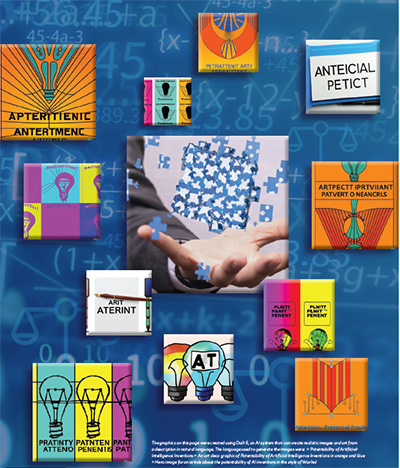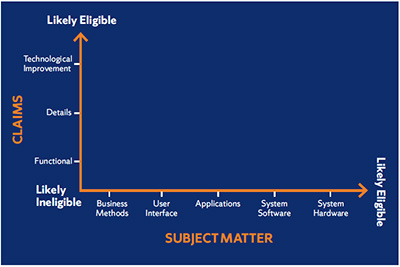by Michael Kiklis L’93
When studying Artificial Intelligence (AI) in the 1980s, I never thought it would become such a mainstream, hot topic as it is today. Its promising advances are being discussed everywhere, even at the kitchen table. The promotion of AI is important to our society, and such promotion is perhaps best accomplished by the U.S. patent system. This article discusses the case law governing the patentability of AI inventions. In short, AI inventions are patent eligible, but they must overcome several hurdles.

AI Definition
AI has been the focus of research since the 1950s.2 There are many definitions for AI, but most include simulating human activity (such as robotics) and providing decision support (such as suggesting an optimal network configuration based on network activity). This article focuses on the patentability of decision support systems, which include machine learning. Decision support systems usually analyze data, which could be a static data set or dynamically derived data, like network activity. They then provide recommendations by, for example, displaying them or even automatically implementing those changes. Neural networks are a common tool for use in such systems.
Patentable Subject Matter Overview
The statute governing patentable subject matter is very broad, for it states “Whoever invents or discovers any new and useful process, machine, manufacture, or composition of matter, or any new and useful improvement thereof, may obtain a patent therefor, subject to the conditions and requirements of this title.”3 The Supreme Court has recognized several judicial exceptions that limit patent eligibility: “Excluded from such patent protection are laws of nature, natural phenomena, and abstract ideas.”4 The rationale for these exclusions is that “these exceptions are ‘part of the storehouse of knowledge of all men … free to all men and reserved exclusively to none.’”5 When and how these exceptions are applied are perhaps the most challenging part of a § 101 analysis.
Patentability of Computer-Related Inventions
The Supreme Court first dealt with computer-related inventions in a trilogy of cases. First, in Benson, the Supreme Court struck down a binary-coded decimal to pure binary conversion program, leaving it up to Congress to decide whether to patent these inventions.6 Next, Flook dealt with a method for updating alarm limits using a mathematical formula and again struck down the invention because the only difference “between the conventional methods of changing alarm limits and that described in respondent’s application rests in the second step—the mathematical algorithm or formula.”7 In this “point-of-novelty” test, the formula (a law of nature) is ignored and the rest of the claim must be novel.8 The last in the trilogy of cases was Diehr, where the Court rejected the point-of-novelty test, stating that “The ‘novelty’ of any element or steps in a process, or even the process itself, is of no relevance” in a § 101 inquiry.9 Then, decades later, the Supreme Court in Mayo seemingly resurrected the point-of-novelty test but left Diehr intact.10 This is the cause of much difficulty today.11
The current § 101 analysis—as explained by the Supreme Court in Alice—is a two-part test: (1) determine if the claims are directed to one of the judicial exclusions, such as an abstract idea; and if so, (2) “consider the elements of each claim both individually and as an ordered combination to determine whether the additional elements transform the claim into a patent-eligible application” by reciting an inventive concept, which must be more than a generic computer.12 This test caused much concern for software patents because the novelty in those inventions is found in the processing of the software itself, rather than in the hardware. Luckily, in Enfish, the Federal Circuit clarified that software is not “inherently abstract” and can be patent eligible.13
Patent Eligibility of AI Inventions
As the Federal Circuit’s case law evolved after Alice, it generated yet another hurdle for decision support systems in the Electric Power Group line of cases.14 In Electric Power Group, the Federal Circuit held that collecting information, analyzing that information, and presenting the results is an abstract idea.15 This means that many decision support systems may fail step one in the § 101 analysis, requiring that such systems recite an inventive concept—more than a generic computer—to be patent eligible. Electric Power Group is therefore dangerous for AI inventions. Although this line of cases is evolving and expanding, other cases provide help.
The courts have found patent eligibility in a number of situations potentially applicable to AI inventions. First, both the Supreme Court and the Federal Circuit have found patent eligibility where the invention improves the functioning of the computer itself. 16 Second, the Federal Circuit has found patent eligibility when the claimed invention provides a technical improvement over the prior art.17 Third, the Federal Circuit has found patent eligibility where the claims recite a technical solution to a technical problem,18 and fourth, the Federal Circuit has found patent eligibility when conventional elements are arranged in a non-conventional way.19 Should an AI invention fit into one of these categories, it will likely be found patent eligible as long as those features are both described in the patent specification and claimed.
There are other concerns beyond the Electric Power Group line of cases for AI inventions. For example, the Federal Circuit is very willing to strike down functionally drafted claims regardless of their subject matter.20 Also, the Federal Circuit has found no business method patents after Alice satisfy § 101.
Empirical Summary of § 101 Cases
The Federal Circuit § 101 cases post Alice can be somewhat confusing to reconcile. However, when viewed based on claim analysis and the invention’s subject matter, a pattern emerges as shown in the following graph. The y-axis shows patent eligibility based on the patent’s claims, with those drafted functionally faring the worst, those drafted with technical details faring better, and those reciting a technological improvement faring the best. The x-axis shows patent eligibility based on the claim’s subject matter. Claims directed to business methods fare the worst, claims directed to user interfaces fare better, claims directed to applications fare better still, and claims directed to system hardware and software fare the best.

Conclusion
AI inventions may face more patent-eligibility difficulties than other technologies based on the Electric Power Group line of cases. But where the specification and claims describe the technological advantages and other features that the Federal Circuit equates with patent eligibility, AI inventions should pass § 101 muster.


